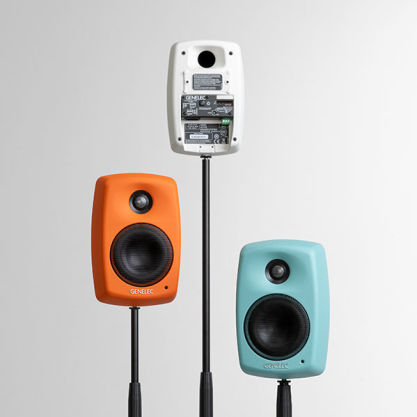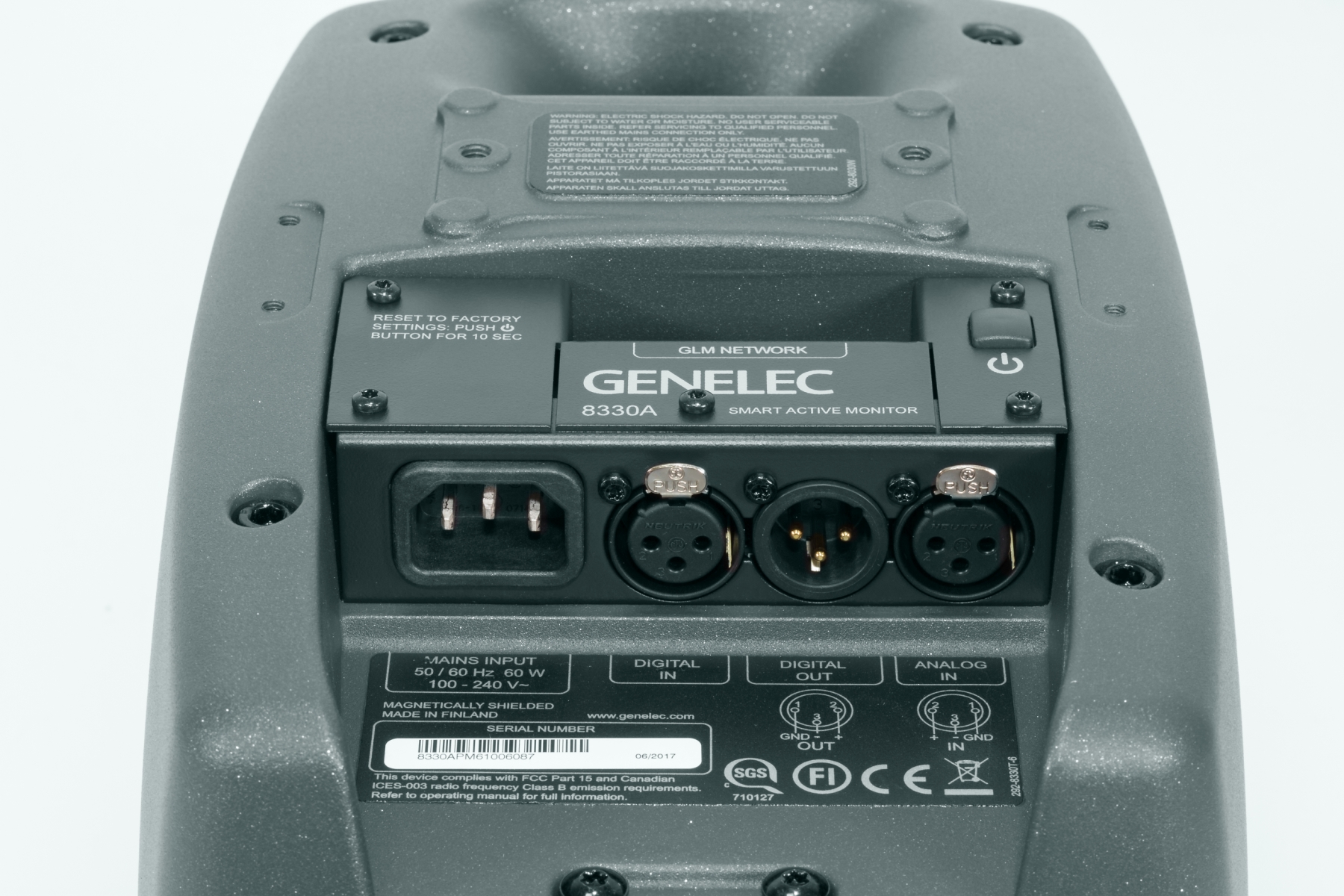This is a review and detailed measurements of the Genelec 8330A studio monitor (powered speaker). It was kindly purchased by a member and drop shipped to me. The 8330A costs US $895 each.
The 8330a naturally follows the current design style of Genelec 2-way non-coaxial speakers:

This is part of the smart speakers from Genelec so naturally sports Ethernet connectivity:

I performed a factory reset before testing. I was surprised how sensitive the input was. I had to really dial down the output on my Klippel analyzer to measure it. I expect devices targeting professional market to have less gain by default when using XLR connections.
Measurements that you are about to see were performed using the Klippel Near-field Scanner (NFS). This is a robotic measurement system that analyzes the speaker all around and is able (using advanced mathematics and dual scan) to subtract room reflections (so where I measure it doesn't matter). It also measures the speaker at close distance ("near-field") which sharply reduces the impact of room noise. Using computational acoustics, far-field response is computed and that is what I present. Both of these factors enable testing in ordinary rooms yet results that can be more accurate than an anechoic chamber.
I performed over 1000 measurement which resulted in error rate of about 1%. Clean high frequency response is responsible for ease of measurement in this regard.
Reference axis is approximately the outer rim of the woofer as instructed in the manual.
Genelec 8330A Measurements
Acoustic measurements can be grouped in a way that can be perceptually analyzed to determine how good a speaker is and how it can be used in a room. This so called spinorama shows us just about everything we need to know about the speaker with respect to tonality and some flaws:

I am so used to nearly ruler flat on-axis response from Genelec that the little bit of variation around crossover region stands out. As does some directivity error. Here is the near-field response:

Can't figure out why the woofer response is sloping down and then rising. That is responsible for on-axis response going above flat response.
Early window reflections are less smooth than I expect from Genelec:

Fortunately it all averages out quite well for far field listening:

I was surprised to see the clipping light (amber and red) come on during the bass region of 96 dBSPL sweeps. Measurements show that the speaker is outside of its comfort at that level:


Ignoring the bit of directivity error around crossover, the rest of the response horizontally is good:


Vertically response is above average with good bit of leeway above and below tweeter axis before you get into trouble:

We see the directivity error at 3 kHz visualized better in our 3-D contour map:

Notice how the pattern has become quite directional and complex.
Finally, here are the timing graphs for the fans of such:

We see some clear resonances around 2 kHz center frequency.

Genelec 8330A Listening Tests
It doesn't take but a minute of listening to know that a) the tonality is right and b) matches other Genelec speakers. I attempted to EQ out the resonances around 2 kHz but it was hard to decide whether that was always an improvement or not. Taking that out makes the speaker sound a bit warmer but also more closed in. It is subtle though.
Dynamic range even in near field listening that I was using is not great. It is easy to get the red clipping light to come on during playback of anything with bass notes. Mind you, it is reasonably loud before that but it just isn't enough.
Conclusions
By most other speakers, the Genelec 8330A speakers have excellent measurements. But using a much higher standard, I feel that they are not as well matched and executed as the 8320A which I reviewed before. The larger woofer has resulted in less perfect crossover response. And there is not enough amplification here to do the speaker justice.
Still, if you don't exceed its playback limits, you have a wonderful sounding speaker here. Tonality is almost as good as it gets. It is not only correct but very enjoyable.
I am going to recommend the Genelec 8330A.
-----------
As always, questions, comments, recommendations, etc. are welcome.
Any donations are much appreciated using: https://www.audiosciencereview.com/forum/index.php?threads/how-to-support-audio-science-review.8150/
The 8330a naturally follows the current design style of Genelec 2-way non-coaxial speakers:
This is part of the smart speakers from Genelec so naturally sports Ethernet connectivity:
I performed a factory reset before testing. I was surprised how sensitive the input was. I had to really dial down the output on my Klippel analyzer to measure it. I expect devices targeting professional market to have less gain by default when using XLR connections.
Measurements that you are about to see were performed using the Klippel Near-field Scanner (NFS). This is a robotic measurement system that analyzes the speaker all around and is able (using advanced mathematics and dual scan) to subtract room reflections (so where I measure it doesn't matter). It also measures the speaker at close distance ("near-field") which sharply reduces the impact of room noise. Using computational acoustics, far-field response is computed and that is what I present. Both of these factors enable testing in ordinary rooms yet results that can be more accurate than an anechoic chamber.
I performed over 1000 measurement which resulted in error rate of about 1%. Clean high frequency response is responsible for ease of measurement in this regard.
Reference axis is approximately the outer rim of the woofer as instructed in the manual.
Genelec 8330A Measurements
Acoustic measurements can be grouped in a way that can be perceptually analyzed to determine how good a speaker is and how it can be used in a room. This so called spinorama shows us just about everything we need to know about the speaker with respect to tonality and some flaws:
I am so used to nearly ruler flat on-axis response from Genelec that the little bit of variation around crossover region stands out. As does some directivity error. Here is the near-field response:
Can't figure out why the woofer response is sloping down and then rising. That is responsible for on-axis response going above flat response.
Early window reflections are less smooth than I expect from Genelec:
Fortunately it all averages out quite well for far field listening:
I was surprised to see the clipping light (amber and red) come on during the bass region of 96 dBSPL sweeps. Measurements show that the speaker is outside of its comfort at that level:
Ignoring the bit of directivity error around crossover, the rest of the response horizontally is good:
Vertically response is above average with good bit of leeway above and below tweeter axis before you get into trouble:
We see the directivity error at 3 kHz visualized better in our 3-D contour map:
Notice how the pattern has become quite directional and complex.
Finally, here are the timing graphs for the fans of such:
We see some clear resonances around 2 kHz center frequency.
Genelec 8330A Listening Tests
It doesn't take but a minute of listening to know that a) the tonality is right and b) matches other Genelec speakers. I attempted to EQ out the resonances around 2 kHz but it was hard to decide whether that was always an improvement or not. Taking that out makes the speaker sound a bit warmer but also more closed in. It is subtle though.
Dynamic range even in near field listening that I was using is not great. It is easy to get the red clipping light to come on during playback of anything with bass notes. Mind you, it is reasonably loud before that but it just isn't enough.
Conclusions
By most other speakers, the Genelec 8330A speakers have excellent measurements. But using a much higher standard, I feel that they are not as well matched and executed as the 8320A which I reviewed before. The larger woofer has resulted in less perfect crossover response. And there is not enough amplification here to do the speaker justice.
Still, if you don't exceed its playback limits, you have a wonderful sounding speaker here. Tonality is almost as good as it gets. It is not only correct but very enjoyable.
I am going to recommend the Genelec 8330A.
-----------
As always, questions, comments, recommendations, etc. are welcome.
Any donations are much appreciated using: https://www.audiosciencereview.com/forum/index.php?threads/how-to-support-audio-science-review.8150/












